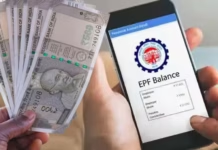The maximum withdrawal amount can be made up to three times in the above mentioned situations till the child turns 18 years of age. Vatsalya Yojana gives parents a great opportunity to secure their child’s future through compounding returns.
NPS Vatsalya is a special scheme launched under the National Pension System (NPS), which is specially designed for the future of children. Under NPS Vatsalya (NPSV), parents can start saving for their child’s retirement even before they turn 18 years old.
When the child turns 18, the NPS Vatsalya account will automatically be converted into a regular NPS (National Pension Scheme) account, which is currently the most effective retirement investment plan.
As the parent or guardian of the child, you have to deposit an initial amount of Rs 1,000 at the time of opening the account. After that, it is necessary to make an annual contribution of at least Rs 1,000 every year. There is no maximum investment limit in this scheme.
Withdrawal rules from NPS Vatsalya account
Parents or guardians can withdraw up to 25% of the amount from the Vatsalya account after three years for select reasons:
- For education
- Certain diseases
- In case of disability
Until the child turns 18, they can withdraw money up to three times in the above mentioned situations. Vatsalya Yojana gives parents a great opportunity to secure their child’s future through compounding returns. When compared to investment schemes like Sukanya Samriddhi Yojana (MF), Public Provident Fund (PPF) and Mutual Fund (MF), some prescribed limits apply to Vatsalya Yojana.
NPSV vs MF vs PPF: Which scheme is better for the child’s future?
Based on the features of each scheme, the comparison between the two schemes can be done as follows:
- Risk and Return: Equity mutual funds generally have higher risk and return potential than NPS Vatsalya. NPS Vatsalya offers a more balanced investment option with a combination of equity and debt investments.
- Liquidity: Equity mutual funds have more liquidity than NPS Vatsalya, as in MFs you can withdraw your money at any time. NPS Vatsalya has a lock-in period till your child turns 18. Even after that, you can withdraw only a part of the fund.
- Retirement Focus: NPS Vatsalya is primarily designed for saving for retirement. On the other hand, equity mutual funds can be used for a variety of financial goals.
“If your child is 10 years old now and you open a pension account for him, a monthly deposit of Rs 10,000 can create a fund of Rs 10 crore in the next 50 years. However, assuming an inflation rate of 6%, the value of this fund will be only Rs 50 lakh at that time. However, if the investment is increased by 10% every year, a strong retirement fund can be easily created for your children.
Other investments like Sukanya Samriddhi Yojana or Mutual Fund Child Plans are designed in such a way that regular investments will help you raise funds for important milestones in your child’s life such as higher education, business and marriage. Mutual funds are specifically designed for the purpose of meeting children’s expenses and are actively managed.
Also, they have a long lock-in period to earn high returns of 12-15%. Though they are associated with market risks, in the long term, they are very profitable. They are able to deal with this. This means that you have a lot of funds and liquidity when investing in it.
“You can avail of the funds at the specific time when you need them the most,” said Adhil Shetty, CEO, BankBazaar.com. For example, if you have invested Rs 5,000 in two mutual fund schemes, one for 8 years and the other for 12 years, you will have liquidity of around Rs 8 lakh and Rs 15 lakh at each stage. In comparison, you will be able to withdraw a maximum of 25% of the amount from the Vatsalya scheme.
Shetty said, “If you decide to do this at the end of the 12th year, you will get around Rs 6.3 lakh. If you adjust the amount of investment in your child plan mutual fund according to your need, then you will be able to complete your child’s graduation and post graduation education without putting too much pressure and without putting a big financial burden on yourself. All this will not be possible due to the low returns and low liquidity of NPS Vatsalya.
Also Read- EPFO’s new rule: Automatic EPF account transfer from old job to new job, know what is automatic EPF account transfer facility
He told that NPS Vatsalya scheme works as a very long term investment scheme. Despite this, it does not provide the flexibility needed. Therefore, it would be a good idea to diversify your investment and adopt NPS Vatsalya as a small part of your overall investment portfolio instead of choosing it as the only investment scheme for your children. Along with this, you should also include mutual fund schemes in your portfolio. should be included.”
NPS Vatsalya vs FD
- Returns: Fixed deposits i.e. FDs usually offer lower returns than NPS Vatsalya and equity mutual funds.
- Liquidity: Fixed deposits are highly liquid, so you can withdraw your funds at any time.
- Risk: Fixed deposits are considered to be the lowest risk investment.
NPS vs SSY and PPF
“Suppose you invest Rs 1000 per month or Rs 12,000 per year in NPS Vatsalya for 18 years. Based on the past performance of NPS and the 75% equity limit, Vatsalya is expected to give a return of around 10%. This means that after 18 years you will have a fund of Rs 6,05,568. But, the problem is that you will be able to withdraw only 20% of the amount when needed.
In such a case, you will get only about Rs 1,21,000 for your child’s higher education. On the other hand, a 100% equity-based investment of the same amount with a minimum return rate of 12% can give you Rs 7,65,439 after 18 years. You can withdraw the entire amount for your child’s higher education or other needs. Just remember that if you do this, you will have to spend on the benefits you get from the scheme Tax will have to be paid.
If you invest the same amount for a period of 15 years, you will get around Rs 4,41,000 in PPF. About Rs 4,94,100 will be deposited in Sukanya Samriddhi Yojana (SSY), out of which you will be able to withdraw only 50% in the 18th year. In this way, both PPF and SSY are better options than Vatsalya because of fulfilling your goals, tax saving and interest income being tax free.
Tushar Bopche, co-founder of Invest4Edu, said that remember, Vatsalya is a pension scheme, which is designed for a very long period and it is a scheme with a traditional approach. Therefore, it should also be used in the same way. For future plans like secondary and higher education of the child, parents should consider investing in different options like mutual funds and PPF as these offer high returns and better liquidity.
One of the major benefits of NPS Vatsalya is its compounding power, which can create a decent corpus over time. For example, investing Rs 10,000 every month can give you over Rs 11 crore on retirement. However, the funds are locked in till the child turns 60, with limited withdrawal options before that, making it useless for education or initial financial needs.
In contrast, SSY and PPF offer more flexibility and liquidity with tax-free returns. For example, investing Rs 10,000 per month in SSY at 7.6% interest for 15 years will create a fund of about Rs 40 lakh, which can be accessed for the child’s education or marriage when the child turns 18. Mutual funds also offer high returns with complete flexibility in terms of withdrawal. Vinayak Mehta, Founder, The Infinity Group said, “NPS Vatsalya is a strong retirement tool, but it is not very suitable for short-term purposes like education, business and marriage.”
Choosing the right option
Choosing the best investment for your child’s future depends on your financial goals, risk appetite and investment period. If you are looking for an investment scheme focused on long-term retirement with tax benefits and a balanced risk-return profile, NPS Vatsalya can be a suitable option. In contrast, if you prefer high returns and liquidity, equity mutual funds or mutual funds specifically designed for children may be a better option.
Related Articles:-
RTGS and NEFT: Now sending money through RTGS and NEFT will allow verification of beneficiary name















